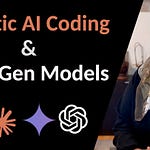Windsurf (formerly Codeium), which was recently acquired by OpenAI for $3B, is a notable player in AI-assisted coding. It focuses on code integrity and test generation. It emphasizes broad IDE support and also offers enterprise solutions.
The Windsurf plugin distinguishes itself with a strong emphasis on user choice when it comes to the underlying AI models.
Its “Write with” feature lets you select from a variety of LLMs for any given task.
The model menu includes options from multiple providers, such as OpenAI’s o3 and GPT-4.1, Google’s Gemini 2.5 Pro, and Anthropic’s Claude 3.7 and Claude Sonnet 4. This allows developers to pick the right tool for the job, balancing performance, cost, and specific capabilities.
Why Enterprises Trust Windsurf (SOC 2 & Self-Hosting)?
They’ve emphasized security by achieving SOC 2 Type II compliance. This is a big deal because it means:
They’ve implemented robust security controls,
passed rigorous audits,
demonstrated consistent security practices over time,
and maintained detailed documentation of their security measures.
For AI code assistants that handle sensitive code, this level of security certification is critical to protect against unauthorized access and data breaches. Windsurf also offers self-hosted options for enterprises, which can be a crucial factor for companies with strict data privacy requirements.
The "Agentic IDE" & Advanced Features (Cascade & Flows)
Offering such robust, enterprise-focused solutions, especially in light of its recent high-profile acquisition by OpenAI, positions Windsurf as a formidable competitor. This intense competition reflects a larger industry dynamic where, as keen observers point out:
“The race to dominate AI-assisted coding [..] is more about capturing the developer workflow, which is rapidly becoming the most monetizable aspect of current LLM technology. [..] And it’s where Windsurf enters the picture.
Founded by Varun Mohan and Douglas Chen, the company began as Exafunction in 2021, focusing on GPU utilization and inference, before pivoting in 2022 to AI developer tools, eventually launching the Windsurf Editor. Windsurf distinguished itself early by being among the first to ship a fully agentic IDE, featuring innovations like context compression at inference time and AST-aware chunking.
Its standout features include “Cascade,” a system providing deep context awareness across an entire codebase for coherent multi-file changes, and “Flows,” designed for real-time AI collaboration where the AI actively understands and adapts to the developer’s ongoing work.” — OpenAI’s $3B Windsurf move
To truly appreciate what makes powerful features like “Cascade” and “Flows” possible, we need to look under the hood. These capabilities are all built upon the AI’s “inference phase” — the critical moment where a trained model applies its knowledge to a new problem.
So, what exactly is inference?
In the world of AI, there are two fundamental stages, as illustrated in the following diagram. The first is the Training Phase, where a model learns by processing massive amounts of training data to recognize patterns.
The second, which is the most relevant stage for a developer, is the Inference Phase. This is the “work” phase — it’s what happens every single time you use an AI code assistant.
The model takes your current code and prompts (the “New Unseen Data”) and uses the knowledge it gained during training. It applies the learned patterns to generate a suggestion, explain a function, or find a bug. In other words, it makes predictions and draws conclusions.
For a software engineer, what you need to understand is that inference is the live, real-time process where the AI proves its worth. Its speed and efficiency are critical for a good user experience.
An innovation like “context compression at inference time” is hugely important because it means the assistant can process the necessary context from your code faster and more cheaply, leading to quicker suggestions without sacrificing quality. It’s a direct solution to the engineering challenge of making powerful AI practical and responsive enough for daily use.
Further Reading and Viewing
🎥 Why I Deleted VS Code After Trying Cursor AI (It's Not Even Close)
🎥 Agentic AI Coding, Next-Gen Models & Prompt Engineering Explained
🎥 Prompt Engineering 101: These Prompting Techniques Will Change How You Code Forever
📖 An Inside Look at the Best AI Coding Models: Claude Opus 4, Gemini 2.5, OpenAI’s o-Series
📖 Welcome to the AI Graveyard: Why 85% of AI Projects Fail (and How to Save Yours)
📖 The Achiever’s Paradox: An Exploration of the Human Quest for Agency
🎁 Special Gift for You
I’ve got a couple of great offers to help you go even deeper. FREE & Discount access to my video courses - available for a limited time, so don’t wait too long!
🔥 Modern Software Engineering: Architecture, Cloud & Security
Discount coupon RAKIA_SOFT_ENG_3🔐 Secure Software Development: Principles, Design, and Gen-AI
FREE coupon RAKIA_SECURE_APPS_2FREE coupon RAKIA_API_DESIGN_2
🐳 Getting Started with Docker & Kubernetes + Hands-On
FREE coupon RAKIA_DOCKER_K8S_2⚡ Master Web Performance: From Novice to Expert
FREE coupon RAKIA_WEB_PERF_2
Until next time—stay curious and keep learning!
Best,
Rakia
Want more?
💡 🧠 I share content about engineering, technology, and leadership for a community of smart, curious people. For more insights and tech updates, join my newsletter and subscribe to my YouTube channel.











